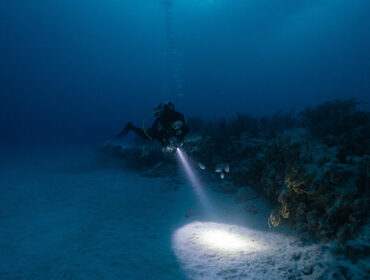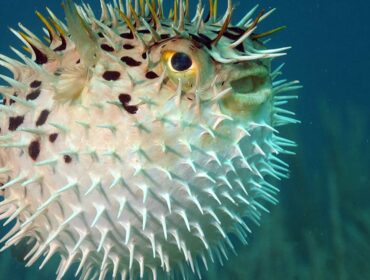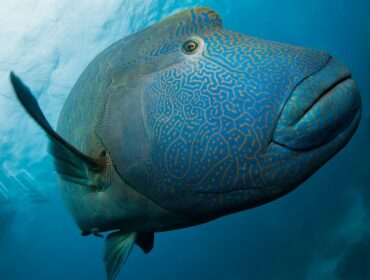As the sun sets, and most of the reefs inhabitants make their way home for the night, there are groups of reef dwelling fish that are just beginning their day. Nocturnal fish make scuba diving at night a fascinating experience as these species of fish are mostly hidden during the day. These fish tend to have larger eyes, are more solitary, slow moving and are often reds or brown in color to make them indistinguishable as the light levels drop. Most nocturnal fish are carnivorous and predatory preying on other reef fish or invertebrates. Here are some of the more commonly sighted creatures of the night you may spot in the glare of your dive light while reef diving.
Cardinalfish
With its brilliant red to light pink colors, the Cardinal fish can be easily found in shallow reefs of the Indo-Pacific at night. This fish has a large head and eyes, a comparatively smaller body and an angled mouth with a protruding lower jaw. The Cardinalfish ranges in size from between 2- 8 inches (5-20cms) in length and there are known to be around 200 species of this fish.
Big Eyes
Bigeyes are carnivorous nocturnal fish that hide by daylight and come out at night. Most bigeyes are bright red in color but can be found in paler shades as well and can grow to a length of about 41 cm (16 inches). Bigeyes are found in almost all of the worlds the oceans in over 18 different species and are often found in large numbers hidden in shipwrecks or caverns during the day. Bigeyes have a peculiar way of swimming; they hang motionless in the water, in order to be able to observe the slightest movement around themselves. Then they suddenly dart forward, to intercept their prey.
Squirrelfish & Soldierfish
Squirrelfish & Soldierfish are perhaps one of the most easily recognized nocturnal reef fish. Known to have pinkish-red color as well as huge eyes these fish are almost completely nocturnal and remain hidden throughout the day. The squirrelfish and Soldierfish are members of the Holocentridae family of fish which comprise of around 80 species inhabiting most of the worlds oceans. Squirrelfish have a poisonous barb near their gills that can give painful stings if touched. Squirrelfish & Soldierfish are known to range in length from 5-50 cm or (6-20 in).
Porcupine Fish
One of the more common night diving sights are Porcupinefish, which like all boxfish, are endearing to look at and have large eyes and a rounded balloon-like body. These slow moving fish appear to swim very awkwardly in the water using their two fins located near their tails. While Porcupinefish are closely related to pufferfish, however porcupinefish have larger spines covering their body almost resembling a porcupine. Like pufferfish they too inflate to almost twice their normal size when threatened and possess a neurotoxin a thousand times more powerful than cyanide if eaten. These fish are nocturnal, choosing to feed at night when their favorite food, mollusks are most active.
Scorpionfish
Scorpionfish are nocturnal hunters that are often difficult to spot owing to their excellent camouflage. This fish hunts by sitting still and waiting until a victim comes close to its mouth. Then it lunges forward, while opening its enormous mouth sucking the victim inside. The body of the Scorpionfish is covered by coarse scales and may contain spines which contain a powerful neurotoxin that is lethal to humans.
Snappers
Snappers can be either nocturnal or diurnal (daytime) fish depending on their species. With over 100 species of snapper, spotting a group of them on a night-dive is relatively easy. Several species of snapper feed on crustaceans and fish and hunt voraciously.
Moray Eels
Moray eels which tend to remain in the nooks and crevices during the day, with only their vicious heads poking out are more at ease at night, and tend to leave their hiding places to swim about scavenging on tiny fish and crustaceans. Perhaps one of the best opportunities for a scuba diver to see an eel’s true length is often on a night dive.
Octopus
While you can spot octopus on the reef during the daytime, at night several species become a lot more active and swim about the reef hunting their favorite invertebrates which also favor the darkness.
Invertebrates
Many invertebrates including lobsters, shrimp, crabs, and other crustaceans, mollusks, polychaete worms, and starfish scavenge the sea beds at night. Starfish especially which remain tucked away during the day seem to appear everywhere at night. Many shrimp migrate to the surface to feed on plankton, and the sea beds are often crawling with lobsters and crabs that brave the open areas under the cover of darkness.
photos from flickr by: doug.deep, jayhem, Nemo’s great uncle, alfonsator, Marcelo Mariozi – , Melissa Bowman & richard ling












